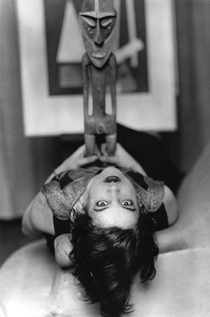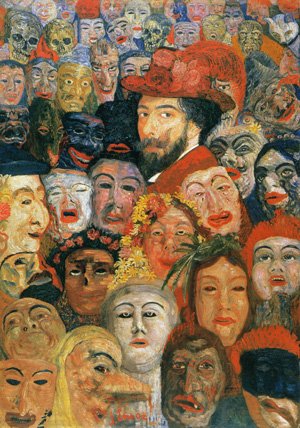“The hollow figure of a human head…” is the way one dictionary defines a mask. But surely there must be more to it. What unkind fate has kept us from using masks in our own time? Why do we continue to neglect these fundamental objects of our spiritual wardrobe? As it is, the gorgeous husks , residences, of benign demons and ancestral ghosts, are just so many exotic ornaments in our eyes, to be classified and catalogued and reduced to “objets d’art”.
Trying them on for size fails to stir in us much empathy for the mythical creatures they represent. We have forgotten that face masks were once part of the cultural baggage of Western man, figuring conspicuously in ritual and on the stage, and sometimes in daily life as well. To this day they enable certain peasant societies to keep in close touch with the supernatural agencies.

Adams:Donati, an Italian-American surrealist whose paintings and sculpture are included in the permanent collections of New York’s Museum of Modern Art and the Guggenheim Museum, among others, bought the masks in early 1945, paying $325 for one and $160 for the other. What make the masks so valuable are their provenance and historic import, their museum-like quality and relative rarity and, oh yes, their beauty. read more: http://www.theglobeandmail.com/news/arts/two-aboriginal-masks-could-fetch-millions-at-art-fair/article1875854/
…James Adams: Enrico Donati doesn’t seem to have been in it for the money. If he had, he would have been rolling in the do-re-mi from a couple of art transactions completed decades before his death, at the age of 99, in 2008.
Instead, it’s Donati’s heirs – and the Canadian art dealer working for them – who stand to be showered by a cascade of cash, perhaps as early as this weekend, when two ceremonial Yup’ik native masks from western Alaska are put up for sale at the 57th annual Winter Antiques Show starting on Friday in Manhattan. The asking price? A little more than $2.1-million (U.S.) for one and “in the region of $2-million” for the other. Expectations are high that each will earn more. If so, it will set a sales record for a North American aboriginal artwork…. Read More: http://www.theglobeandmail.com/news/arts/two-aboriginal-masks-could-fetch-millions-at-art-fair/article1875854/
The Alaskan hunters and Mexican farmers who fashioned sacred masks in the images of bears and tigers were unacquainted with alien religious doctrines. They may never have heard of Egypt’s falcon-headed Horus , or the jackal headed Anubis, or of Thoth, who appears as both baboon and ibis, but except stylistic detail and the choice of materials, their vision of otherworldly beings differs little from that of the ancients. In a way, these primitive artifacts, made from wood and hide, shells and feathers, are every bit as awe inspiring as the indestructible Nilotic deities.

---Its provenance is remarkable having been sold by Twitchell to George Gustav Heye whose collection moved to the Museum of the American Indian, Heye Foundation, in New York in 1916. Several masks, including this one, were de-accessioned in 1944 to the New York dealer Julius Carlebach who sold them to a number of Surrealists including André Breton. The iconic Breton swan mask, by the same hand as the Donati Studio Mask, is now in the Pavillon des Sessions at the Louvre. The Italian-American Surrealist artist Enrico Donati acquired his mask in 1945 and it hung in the Gainsborough Studios on Central Park South for over sixty years, inspiring and influencing his art. The artist’s heirs chose to offer this and another mask, the Donati Fifth Avenue Mask, through the Donald Ellis Gallery rather than at auction. --- read more: http://www.artdaily.com/index.asp?int_new=43695&int_sec=2
Gods being at a discount these days, profane masks may have a brighter future. At any rate, as a means of hiding from fellow creatures, they are sanctioned by historical precedent. They flourished early in Venice, where sumptuary laws mention them as far back as 1295. By the time of the Renaissance they were in common use there, and not only during carnival. Patricians and plebians, prostitutes, mothers with babes in arms, servant girls going to market, even beggars- all wore them in plain daylight.
Adams: …Donati got his masks from a New York dealer who had purchased them in 1944 from the U.S. National Museum of the American Indian, Heye Foundation, in New York when the museum, strapped for cash, began to deaccession some of its collection. Included in the selloff were more than two dozen Yup’ik ceremonial masks collected at the turn of the 20th century by an Alaskan trader named Adams Hollis Twitchell.
The New York dealer, who numbered such New York-based surrealists as André Breton, Yves Tanguy, Marcel Duchamp, Max Ernst and Enrico Donati as friends, knew of their fascination with the fantastical, dream-like imagery in native art and cannily sold them several Yup’ik masks for what now seems a relative pittance…. Read More: http://www.theglobeandmail.com/news/arts/two-aboriginal-masks-could-fetch-millions-at-art-fair/article1875854/ a

YUP’IK MASK, CA.1900 Kuskokwim, Alaska Painted wood, leather
s, height 101 cm Photo: Robert Bayer, Basel, read more: http://www.ikono.tv/blog/?p=5283Their use spread to France and eventually, throughout Europe. Queen Elizabeth rode horsback masked. But nowhere were masks more useful than at the theatre, where they permitted women to enjoy the ribaldries of the stage without betraying their emotions. The last word in mystification was the double mask, whereby a person wore a second mask under an outer one, so that when they took off the first, people thought to see his true face.
Yet true masks are denied us. The only ones we are more or less familiar with are the lusterless mouth aprons of industrial workers, surgeons, and bank robbers, and those less mentionable ones sported on Halloween or KKK outings. As tools for self-realization they seem hopelessly blunt. How much longer then , do we have to wait to catch up with the noble savage, the horse-sensical peasant and the sophisticated mummer of Renaissance times? Although more people than ever want to improve upon their face, the results hardly measure up to their expectations.

Hunter Gorinson:...the role of surrealist photographer Man Ray “in shaping international understanding of African objects as art…in the 1920s and 1930s.” Long before native art became a part of the cultural mainstream, Man Ray — born Emmanuel Radnitsky in 1890 — began to incorporate tribal cravings imported from colonial West Africa into his ethereal portraiture. read more: http://culturemob.com/blog/man-ray-african-art-and-the-modernist-lens-phillips-collection-washington-dc-photography-dada-surrealism
Noses are straightened, teeth recapped, cheeks and double chins gathered up; yet all these makeshift repairs only distract from the radical and ultimate solution of the problem- the escape into the shelter of a “false face” . False hair, false teeth, and glass eyes have been with us since time immemorial, and the false face can’t be far off. Such an interim face would seem to be a logical, if not say unavoidable , stage in the development of more adequate body coverings.
Read More: http://m.economist.com/prospero-21015013.php
http://online.wsj.com/article/SB10001424052748704111504576060061853435924.html?mod=wsj_share_twitter
ADDENDUM:
Laura Allsop: The mask in the Beyeler collection can be manipulated and change form, a factor, Wick said in “why surrealist artists got interested in these pieces,” as well as the fact that they suggest “a dream state.” “Surreal collecting was a kind of wunderkammer, or marvel’s cabinet (cabinet of curiousities), where they gathered all kinds of things that had a certain inspiration,” he said….

Oisteanu:( James Ensor) During the 1880s, his style changed to a mixture of symbolism and expressionism. He took his subject matter principally from holiday crowds, the tradition of Carnival and his family business—selling satirical and grotesque facemasks. Portraying individuals as clowns or skeletons, or replacing their faces with carnival masks, he represented humanity as stupid, smirking, vain and loathsome. read more: http://www.brooklynrail.org/2009/07/artseen/james-ensor
Though undoubtedly important to the development of the Surrealists’ aesthetic, the importance of these masks to the Yup’ik peoples, who lived in harsh, contingent circumstances, was much greater.Ann Fienup Riordan is a cultural anthropologist based in Alaska, and author of book “The Living Tradition of Yup’ik Masks.” Read More: http://www.cnn.com/2011/US/01/19/surreal.yupik.masks/index.html
She said that the masks were used to “to request an abundance for the years to come” — be it good weather, game or driftwood. Shamans and others in the community would experience visions, she said, and then ask expert carvers in the community to make a mask based on that vision. Then they would compose a song and perform it with dancers. After the performance, she said, the masks would be destroyed. “This was a prayer that was done, and they finished it by either burning (the mask) or laying it out on the tundra, and then they would be remade every year for the next dance,” she said. Read More: http://www.cnn.com/2011/US/01/19/surreal.yupik.masks/index.html





 COMMENTS
COMMENTS